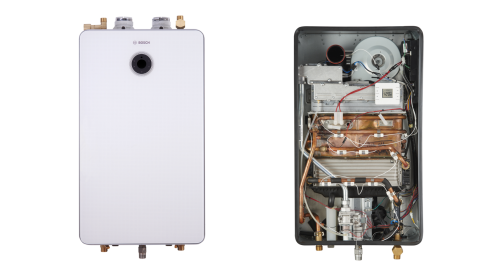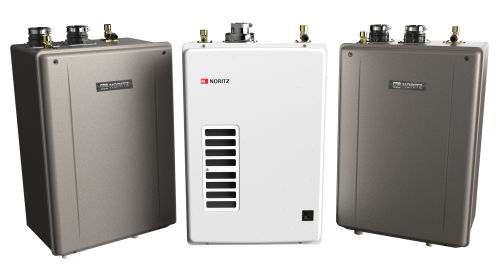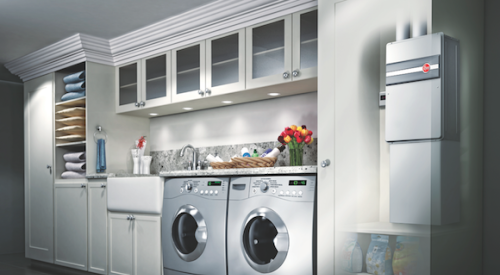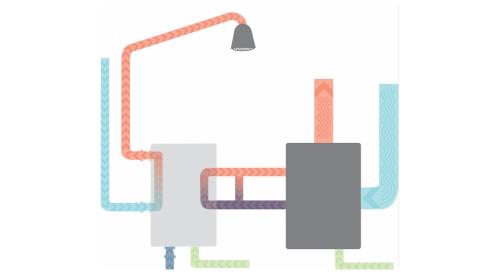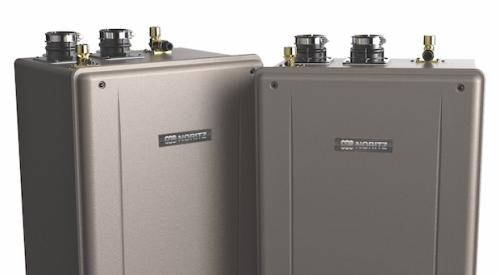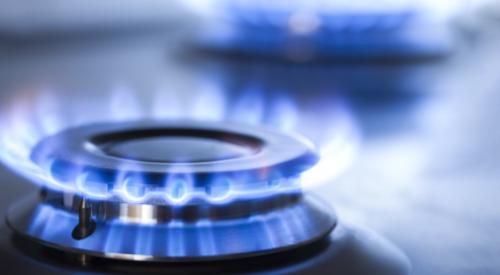|
With water heating accounting for 17–25% of the average household's energy expenditures, it's no wonder new home buyers are looking for ways to save energy — and money — when it comes to their energy bills.
While most homes in North America use a conventional storage tank water heater to provide hot water in the home, in recent years, manufacturers have begun offering tankless water heaters as an alternative. Tankless water heaters, also called demand water heaters, do exactly as the name says — they provide hot water on demand.
As with many newer technologies, there is no shortage of claims promoting the advantages of tankless water heaters — or of countering opinions addressing their shortcomings. Both storage and tankless units offer advantages and disadvantages.
|
Point-of-use systems can be installed directly at the source where hot water will be required. |
One of the biggest differences between conventional water heaters and tankless units is how — or, more precisely, where — they are installed. Larger tankless units, which may provide the hot water needs for an entire household, are typically installed centrally. Tankless heaters, on the other hand, do not necessarily need to be installed as the primary source of hot water for the home and therefore can be installed throughout the house.
Tankless water heaters come in a variety of sizes for different applications including: "point of use" (POU) hot-water sources for remote bathrooms, laundries and hot tubs; tankless models used as boilers to provide hot water for home heating systems; and tankless water heaters used for a single appliance
When selecting the type of hot-water source to install, it is critical to know the demand the unit will be expected to meet. A household that has many users requiring hot water simultaneously will be different from those using comparatively little hot water or those using hot water at different times. For example, homes that regularly have more than one shower or bath being used simultaneously will have different supply needs than those that do not. Dishwashers, washing machines and other hot water appliances must also be factored into the hot-water-demand equation.
The key difference between the two technologies is in the way they provide hot water to meet these various demands:
- Storage tank-type water heaters hold a finite amount of hot water and require energy to heat the water initially and then to keep that stored water hot — continuously — until there is a call for it. Tank heaters are preset to maintain water at a certain temperature: usually between 120°–140° Fahrenheit (49°–60° Celsius). The heater must therefore operate periodically during dormant periods to maintain that preset water temperature. Because a storage tank water heater stores a finite amount of water (30 to 75 gallons), when that capacity has been used, there is a waiting period — called "recovery" time — for the unit to heat new water.
- Tankless water heaters do not store hot water. Water is heated only to meet actual demand, as when someone turns on the shower or washes a load of clothes. It therefore does not consume energy during standby periods. This means that tankless water heaters can offer an energy savings over storage-tank models. However, based on the Energy Department of Energy's Energy Factor (EF) ratings and Estimated Annual Cost of Operation formulas, the energy savings from a tankless heater are estimated to be relatively low (approximately $80 annually).
Usage: Advantages and Disadvantages
While installation may be a prime factor in choosing a water heater, usage can also be a key reason for choosing one water heater technology over another. In looking at water heater usage, it is important to consider the advantages and disadvantages to choosing one technology over another.
Tankless Water Heaters - Advantages. As noted in the cost comparison table on page 92, tankless water heaters cost less to operate on an annual basis and have a longer life expectancy. In addition, installing a smaller tankless unit is ideal for supplementing a conventional storage tank model that provides water for the rest of the home. These small heaters are usually installed in a closet or underneath a sink.
Tankless Water Heaters - Disadvantages. With a tankless unit, those appliances using a large amount of water — for instance, the washing machine and dishwasher — need to be operated separately. However, separate tankless water heaters can be installed to meet individual hot water loads, or two or more water heaters can be connected in parallel for simultaneous demands for hot water. Some manufacturers claim that their product can match the performance of any 40-gallon (151 liter) tank heater.
In addition, tankless water heaters may leak if they are exposed to freezing temperatures or has a manufacturing defect.
Conventional Water Heaters — Advantages. As noted in the cost comparison table on page 92, the unit cost of a conventional water heater is lower than that of a tankless unit. In addition, many builders have used conventional water heaters for years so more is known about these units than about tankless units.
Conventional Water Heaters - Disadvantages. Conventional storage tank water heaters can develop corrosive leaks, resulting in water damage. These units also can decrease in efficiency over time due to mineral build-up inside the tank. This is due to the fact that storage tank water heaters store hot water, giving those minerals a chance to settle out and bake from the heat onto the walls of the tank, and onto the heating element in electrical models, reducing heat transfer.
To fully understand how tankless water heating technology works, one must remember the most important element of tankless technology — it is on demand.
With no storage tank, tankless heaters are required to heat water on demand. When a faucet is opened, the flow of the water triggers the unit's gas burners or electrical elements to turn on, heating the water as it passes through the device.
The time it takes to obtain hot water is directly related to the distance the hot water has to travel from the water heater to its point of use. The burners or elements shut down when the hot water faucet is turned off. Because a tankless water heater turns on when the hot water faucet is open and shuts off when closed, the energy consumed is only for the hot water being used. Again, there is no storage of water and therefore no heating and re-heating of stored water.
Manufacturers of tankless water heaters suggest that their products will result in reduced energy consumption costs and therefore lower environmental impact. They also state that if the appropriate size and number of units are installed, it is possible to have an "endless" supply of hot water. To achieve this, it is important to determine the number of sources requiring hot water at any given time (see Selecting a Tankless Water Heater on page 93).
Tankless units are available in propane (LP), natural gas or electric models. Gas-fired models have a higher hot water output than most electric models.
Cost Comparison
Conventional water heater versus tankless
Unit size for a typical four-person home with 2.5 baths, laundry, and a dishwasher
| Energy Factor | Annual Cost to Operate* | Unit Cost | Life Expectancy | |
| AquaStar 250SX | .85 | $160 | $950 | 20 Years |
| 50-gallon tank | .62 | $241 | $400 | 12 Years |
| *The above charts represent approximate energy savings figures based on the U.S. Dept. of Energy test method for water heaters. The energy costs used are the 2004 averages as published by DOE — $0.91/therm for natural gas. | ||||
|
